长句的翻译方法
【推荐】英语长句翻译的五种方法word版本 (4页)

本文部分内容来自网络整理,本司不为其真实性负责,如有异议或侵权请及时联系,本司将立即删除!== 本文为word格式,下载后可方便编辑和修改! ==英语长句翻译的五种方法一、英语长句翻译所涉及的基本问题科技英语具有逻辑性强、结构严密、表达明确等特点。
这些特点决定了科技英语的一个显著特征是含有大量长句。
英语长句后置修饰语多,并列成份多,句法结构复杂,层次重叠。
因此,进行长句翻译时,要注意英译汉语序上的差异和英汉表达方式的差异。
二、长句翻译的基本方法英语长句汉译时主要采用下列五种方法:顺译法、倒译法、内嵌法、分译法、拆离重组法。
(一)顺译法顺译法是指在英译汉过程中,按原文行文的先后顺序或按内容的逻辑顺序,依次译出的翻译方法。
It is important to remember that the composition of a given grade of steel can be subject to variations within the range of its specification,and such variations in composition,impurity elements and also grainsize caused in hot-working process will result in differences in both response to heat treatment and variations in mechanical properties.重要的是要记住,给定牌号钢的化学成份在其规定范围内可能发生一些变化,这样一些在热加工过程中引起的存在于成份、杂质元素、还有品粒大小上的变化,将使热处理工艺和力学性能产生一些差异。
原句由一个主句、两个宾语从句组成。
由于原句的表达与汉语的表达是基本一致的,因此整个句子的翻译按照原句的语序顺译即可。
The civil engineer must be able to select and utilize effectively the products provided by the other branches of the profession developing consumer goods,such as the materials of construction and industry,including steel,timber,concrete and many other materials;and engaging the modern application and use of steam,electric andgas power engines and machines.土建工程师一定要能够有效地选择和利用本行业和其他部门提供的产品。
英语长难句分析英语长句结构分析及翻译实例
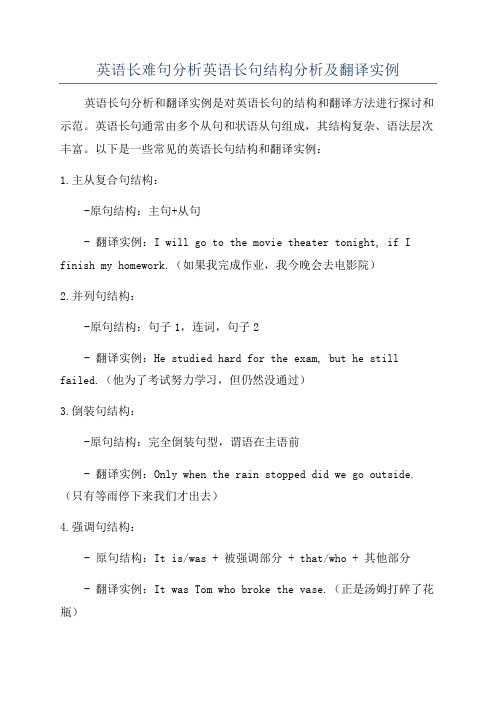
英语长难句分析英语长句结构分析及翻译实例英语长句分析和翻译实例是对英语长句的结构和翻译方法进行探讨和示范。
英语长句通常由多个从句和状语从句组成,其结构复杂、语法层次丰富。
以下是一些常见的英语长句结构和翻译实例:
1.主从复合句结构:
-原句结构:主句+从句
- 翻译实例:I will go to the movie theater tonight, if I finish my homework.(如果我完成作业,我今晚会去电影院)
2.并列句结构:
-原句结构:句子1,连词,句子2
- 翻译实例:He studied hard for the exam, but he still failed.(他为了考试努力学习,但仍然没通过)
3.倒装句结构:
-原句结构:完全倒装句型,谓语在主语前
- 翻译实例:Only when the rain stopped did we go outside.(只有等雨停下来我们才出去)
4.强调句结构:
- 原句结构:It is/was + 被强调部分 + that/who + 其他部分
- 翻译实例:It was Tom who broke the vase.(正是汤姆打碎了花瓶)
对于长句的翻译,可以采取以下方法:
-分割长句,将从句、状语从句分别翻译,再进行合并。
-对英语长句进行拆分,将其翻译为多个简洁且清晰的句子。
-确保翻译的流畅性和准确性,同时要注意语序的变化。
总之,对于英语长句的结构分析和翻译实例,重要的是理解其语法结构、使用正确的连词、灵活运用翻译策略,并保持翻译的准确和自然。
英语长句的翻译方法

长句的翻译方法1.顺序翻译法(1)The problem is that the last generation or so we’recome to assume that womenshould be able, and should want, to do everything that bytradition men have done at thesame time as prettywelleverything that by traditionwomen have done.问题是,在过去二十年时间里,我们已经认定,妇女们应该能够且应该想做男人们想做男人们传统上所做的一切,而同时也能够做得跟妇女们传统上所做的一切同样好。
(2)Exercise*Prior to the twentieth century, women in novels werestereotypes of lacking anyfeatures that made them uniqueindividual and were alsosubject to numerousrestrictions imposed by themali-dominated culture.2. 逆序翻译法(1)It therefore becomes more and more important that, ifstudents are not to wastetheir opportuniti es,therewill have to be muchdetailed information aboutcourses and advice.因此,如果要使学生充分利用(上大学)的机会,就得为他们提供关于课程的更为详尽的信息,作更多的指导。
这个问题显得越来越重要了。
(2)Exercises*It is probably easier for teachers than for students to appreciate the reason why learning English seems to become increasingly difficult once the basic structures andpatterns of the language have been understood.*A great number of graduate students were driven into the intellectual slum when in the United States the intellectual poor because the classic poor, the poor under the rather romantic guise of the beat generation, a real phenomenon in the later fifties.*Such a human nature in the west that a great many people are often willingto sacrifice higher pay for the privilege ofbecoming white collar workers.*Clear-cut guidelines and politics have been worked out and expressed in accurate language concerning the economy, politics, science and technology, education, culture and military and foreign affairs.3. 分译法翻译英语句子时,有时我们可以把原文的句子结构整个保存下来或只作稍改变即可,但在不少情况下则必须将原来的句子结构作较大的改变。
长句的翻译
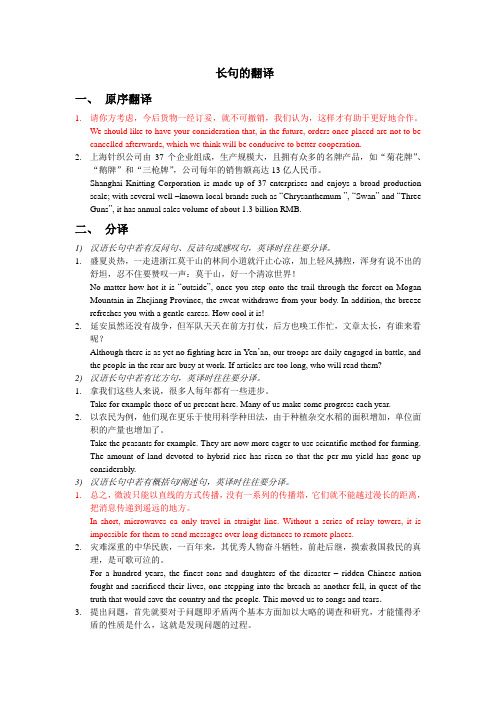
长句的翻译一、原序翻译1.请你方考虑,今后货物一经订妥,就不可撤销,我们认为,这样才有助于更好地合作。
We should like to have your consideration that, in the future, orders once placed are not to be cancelled afterwards, which we think will be conducive to better cooperation.2.上海针织公司由37个企业组成,生产规模大,且拥有众多的名牌产品,如“菊花牌”、“鹅牌”和“三枪牌”,公司每年的销售额高达13亿人民币。
Shanghai Knitting Corporation is made up of 37 enterprises and enjoys a broad production scale; with several well –known local brands such as “Chrysanthemum ”, “Swan” and “Three Guns”, it has annual sales volume of about 1.3 billion RMB.二、分译1)汉语长句中若有反问句、反诘句或感叹句,英译时往往要分译。
1.盛夏炎热,一走进浙江莫干山的林间小道就汗止心凉,加上轻风拂煦,浑身有说不出的舒坦,忍不住要赞叹一声:莫干山,好一个清凉世界!No matter how hot it is “outside”, once you step onto the trail through the forest on Mogan Mountain in Zhejiang Province, the sweat withdraws from your body. In addition, the breeze refreshes you with a gentle caress. How cool it is!2.延安虽然还没有战争,但军队天天在前方打仗,后方也唤工作忙,文章太长,有谁来看呢?Although there is as yet no fighting here in Yen’an, our troops are daily engaged in battle, and the people in the rear are busy at work. If articles are too long, who will read them?2)汉语长句中若有比方句,英译时往往要分译。
汉译英长句的翻译方法
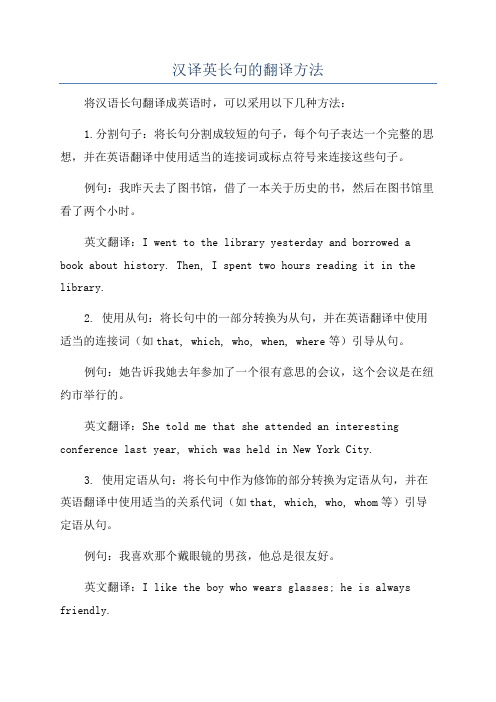
汉译英长句的翻译方法将汉语长句翻译成英语时,可以采用以下几种方法:1.分割句子:将长句分割成较短的句子,每个句子表达一个完整的思想,并在英语翻译中使用适当的连接词或标点符号来连接这些句子。
例句:我昨天去了图书馆,借了一本关于历史的书,然后在图书馆里看了两个小时。
英文翻译:I went to the library yesterday and borrowed a book about history. Then, I spent two hours reading it in the library.2. 使用从句:将长句中的一部分转换为从句,并在英语翻译中使用适当的连接词(如that, which, who, when, where等)引导从句。
例句:她告诉我她去年参加了一个很有意思的会议,这个会议是在纽约市举行的。
英文翻译:She told me that she attended an interesting conference last year, which was held in New York City.3. 使用定语从句:将长句中作为修饰的部分转换为定语从句,并在英语翻译中使用适当的关系代词(如that, which, who, whom等)引导定语从句。
例句:我喜欢那个戴眼镜的男孩,他总是很友好。
英文翻译:I like the boy who wears glasses; he is always friendly.4.利用省略:可以在英语翻译中省略一些不重要或重复的信息,使句子更清晰和简洁。
例句:我昨天和朋友一起去了看电影,然后吃了晚饭。
英文翻译:I went to watch a movie with my friends yesterday and had dinner afterwards.以上是一些常用的翻译方法,根据具体语境和句子结构的复杂程度,可以选择适合的方法进行翻译。
英语长句的翻译方法

长句的翻译方法1.顺序翻译法(1)The problem is that the last gerention or so we’re come to assume that women should be able, andshould want, to do everything that by traditionmen have done at the same time as prettywelleverything that by tradition women have done.问题是,在过去二十年时间里,我们已经认定,妇女们应该能够且应该想做男人们想做男人们传统上所做的一切,而同时也能够做得跟妇女们传统上所做的一切同样好。
2. 逆序翻译法(1)It therefore becomes more and more important that, if students are not to waster their opportunities,there will have to be much detailed informationabout courses and advice.因此,如果要使学生充分利用(上大学)的机会,就得为他们提供关于课程的更为详尽的信息,作更多的指导。
这个问题显得越来越重要了。
3. 分译法翻译英语句子时,有时我们可以把原文的句子结构整个保存下来或只作稍改变即可,但在不少情况下则必须将原来的句子结构作较大的改变。
把原文的一个简单句译成两个或两个以上的句子,这叫分译法。
使用分译法,可以把原句中的一个词,一个短语或一个句子分译成两个或两个以上的句子。
一、把原文中单词译成句子(一)副词1.They tried vainly to blame us for the breakdown in the truce talk.他们试图把和谈的罪名加在我们头上,但没得逞。
长句的翻译

译文: 由于人民生活水平的不断提高以及计划生育, 中国的家庭结构发生着缓慢却又具有实质性的变化, 必须根据这一历史背景考虑人到老年的问题。
分析:这是一个因果句,against 引导一个原因状语从 句。按照汉语先说原因后说结果,先叙述事实后表明 见解的习惯,翻译时需倒译。
【4】Such is human nature in the West that a great many people are often wiling to sacrifice higher pay for the privilege of becoming white collar workers.
down and sending out wireless messages, the lieutenant(中尉) confusedly studying the map to
make out what the messages meant and appealing for aid now and then to the sergeant(中士) .
译文: 这个年轻人走了很远的路之后碰上了一个愚蠢的人,这个 人把一条裤子系在两棵树之间,正在尽全身力气向上跳,想在落 下来时两条腿正好套进两只裤脚里去。
二、逆译法
如果语序跟汉语习惯不同,甚至完全相反时。
2.1 改变定语顺序 (前置到先行词前)
【2】 The battle-scarred old communists who once made stormy revolution unfurled a passionate blueprint today for a modern, peaceful and prosperous China .
英语长句翻译方法

英语翻译过程中,英语长句的译法大致可采取以下四种方法来进行。
一、顺序法有的英语句子虽长,但它所叙述的动作基本上是按时间顺序、地点顺序或逻辑关系安排的,这与我们中国人的思维方式相吻合,因此,翻译时可依从原文语序。
例: In Africa I met a boy, who was crying as if his heart would break, said,when I spoke to him, that he was hungry because he had had no food for two days.分析:此句不算很长,但主句宾语a boy 细藤结大瓜似地带着一个非限制性定语从句直贯句尾,而从句中又有宾语从句that he was hungry because he had had no food for two days. 此宾语从句中的划线部分又是一个原因状语从句,整个句框形成三级从句;宾语从句中的谓语动词said 与它的宾语从句之间又为一时间状语when I spoke to him 所隔。
翻译时若要体现这纷繁复杂的语法关系简直难以行文,因而译文按照原文的顺序,将所发生的事情依序道来,虽未复现原文中诸从句与其被修饰语的关系,但原文的思想内容无一遗漏,叙述脉络清晰,符合逻辑关系和汉语行文习惯。
译文:在非洲,我遇到了一个男孩,他哭得伤心极了,我问他时,他说他饿了,两天没有吃饭了。
二、逆序法有些英语长句的表达次序与汉语习惯不尽相同甚至恰恰相反,这就要求我们在翻译时须逆着原文,从后面译起。
例: Is it our sound and considered judgment that the tougher subjects of the classics and mathematics should be thrown aside, as suggested by some educators, for doll- playing?分析:原文为了句子结构的平衡用形式主语“it”代替冗长的主语从句,而汉语中没有相同的句子结构,译文逆着原文的顺序先译主语从句的内容再译主句框架,将原文的意义表达得一清二楚,口气语势也与原文一般无二。
英语长句的翻译技巧
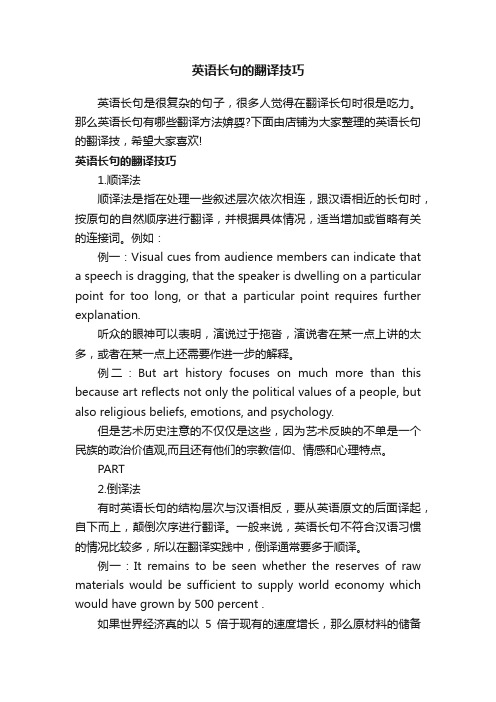
英语长句的翻译技巧英语长句是很复杂的句子,很多人觉得在翻译长句时很是吃力。
那么英语长句有哪些翻译方法媕娿?下面由店铺为大家整理的英语长句的翻译技,希望大家喜欢!英语长句的翻译技巧1.顺译法顺译法是指在处理一些叙述层次依次相连,跟汉语相近的长句时,按原句的自然顺序进行翻译,并根据具体情况,适当增加或省略有关的连接词。
例如:例一:Visual cues from audience members can indicate that a speech is dragging, that the speaker is dwelling on a particular point for too long, or that a particular point requires further explanation.听众的眼神可以表明,演说过于拖沓,演说者在某一点上讲的太多,或者在某一点上还需要作进一步的解释。
例二:But art history focuses on much more than this because art reflects not only the political values of a people, but also religious beliefs, emotions, and psychology.但是艺术历史注意的不仅仅是这些,因为艺术反映的不单是一个民族的政治价值观,而且还有他们的宗教信仰、情感和心理特点。
PART2.倒译法有时英语长句的结构层次与汉语相反,要从英语原文的后面译起,自下而上,颠倒次序进行翻译。
一般来说,英语长句不符合汉语习惯的情况比较多,所以在翻译实践中,倒译通常要多于顺译。
例一:It remains to be seen whether the reserves of raw materials would be sufficient to supply world economy which would have grown by 500 percent .如果世界经济真的以5倍于现有的速度增长,那么原材料的储备是否能充分满足其需求,尚不得而知。
长句的翻译方法

2. 重重叠叠
• “重重叠叠”的方法是指,在翻译时将英语的长句 采取拆句、断句的方法,在汉语译文中重叠使用这 些词语,从而保持原文的畅通。 • This important meeting is followed by a period of scientific certification during which not only first-hand investigation takes place but also such other related information is sought as has been agreed by both part
• “顺流而下”的方法是指,在翻译英语长句时 基本保持原文的语序。也就是说,汉语译文的 语序与英语长句的语序基本保持一致,从而产 生一气呵成的效果。 “逆水而上”的方法是 指,在翻译英语长句时颠倒原文的语序,或者 说,把汉语译文的语序与英语长句的语序基本 颠倒过来。 这种翻译顺序恰巧与“顺流而下” 的翻译方法相反、采用这种翻译方法时,不仅 注意内容的连贯和译文的流畅, 而且要兼顾 原文的逻辑关系和时间顺序。
• 关于你方作我方的计算机代理的请求,我们已 向我方的厂商转达,供他们研究。他们告诉我 们,当我们之间的业务进一步扩大时,他们会 认真地考虑这个问题。
4. “先里后外”
• “先里后外”的方法是指,在翻译英语长句时 采用改变顺序或调整句子结构的方法,首先完 成长句中间的翻译,然后完成长句外围部分的 翻译。采用“先里后外”的翻译方法时,不仅 应该注意内容的连贯和译文的通畅, 而且兼 顾原义的逻辑关系和先后顺序。 • 和“先里后外”的方法恰恰相反, “由外向 内”的方法要求首先完成长句外围部分的翻译, 然后完成长句中间部分的翻译。
汉译英翻译技巧-长句的翻译_大学英语
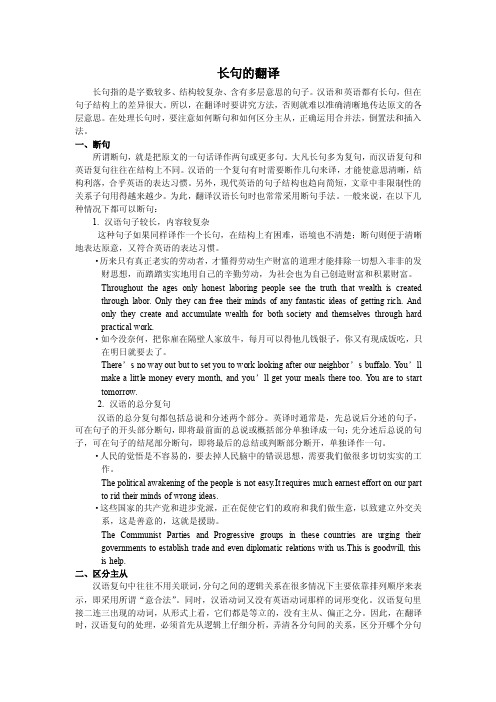
长句的翻译长句指的是字数较多、结构较复杂、含有多层意思的句子。
汉语和英语都有长句,但在句子结构上的差异很大。
所以,在翻译时要讲究方法,否则就难以准确清晰地传达原文的各层意思。
在处理长句时,要注意如何断句和如何区分主从,正确运用合并法,倒置法和插入法。
一、断句所谓断句,就是把原文的一句话译作两句或更多句。
大凡长句多为复句,而汉语复句和英语复句往往在结构上不同。
汉语的一个复句有时需要断作几句来译,才能使意思清晰,结构利落,合乎英语的表达习惯。
另外,现代英语的句子结构也趋向简短,文章中非限制性的关系子句用得越来越少。
为此,翻译汉语长句时也常常采用断句手法。
一般来说,在以下几种情况下都可以断句:1. 汉语句子较长,内容较复杂这种句子如果同样译作一个长句,在结构上有困难,语境也不清楚;断句则便于清晰地表达原意,又符合英语的表达习惯。
·历来只有真正老实的劳动者,才懂得劳动生产财富的道理才能排除一切想入非非的发财思想,而踏踏实实地用自己的辛勤劳动,为社会也为自己创造财富和积累财富。
Throughout the ages only honest laboring people see the truth that wealth is created through labor. Only they can free their minds of any fantastic ideas of getting rich. And only they create and accumulate wealth for both society and themselves through hard practical work.·如今没奈何,把你雇在隔壁人家放牛,每月可以得他几钱银子,你又有现成饭吃,只在明日就要去了。
There’s no way out but to set you to work looking after our neighbor’s buffalo. Y ou’ll make a little money every month, and you’ll get your meals there too. Y ou are to start tomorrow.2. 汉语的总分复句汉语的总分复句都包括总说和分述两个部分。
英语长句翻译步骤

英语长句翻译步骤有人把英语句子比作树式结构,汉语句子比作竹式结构,认为英语句子主干突出,在表达复杂思想时,往往先把主语和主要动词这根主干竖起,再用关联词把各种成分一个个挂靠上去,使整个句子看上去像棵枝繁叶茂的参天大树;汉语句子则如竹子一般,是一节节拼接起来的。
把树式的英语长句翻译成竹式的汉语短句、分句,可以按照以下五步走:一、削去枝蔓,找出主干;二、条分缕析,理清关系;三、确定单位,各个击破;四、调整搭配,重新组合;五、核对原句,润饰译句。
以下面句子为例分析这五步。
例9.A World Bank report released at the time of the conference,which ended on 10 November,insists that Vietnam’s overall growth will depend more on its own policies than on the volume of external financing.一、削去枝蔓,找出主干该句是主从复合句,由一个主句和一个宾语从句组成,主句的主干是A World Bank report... insists that...。
1二、条分缕析,理清关系观察各修饰成分的内部结构,弄清各修饰成分与中心词之间的语法关系和逻辑关系。
例句中,句子主干的主语比较复杂,它自身带有一个由过去分词结构充当的定语,定语中的名词the conference后又带有一个非限定性定语从句which ended on 10 November。
宾语从句中有一个比较结构,也是需要留心的地方。
三、确定单位,各个击破确定翻译单位,逐次转换成汉语。
翻译时通常可把小句当作最佳转换单位,将英语长句拆分成一个个相对独立的小句,再分别转换成相应的汉语小句。
例句由四个小句构成:1. A World Bank report... insists that...;2. (A World Bank report)released at the time of the conference;3. which (= the conference)ended on 10 November;4. Vietnam’s overall growth will depend more on its own policies than on the volume of external financing.可相应地译成:1. 一份世界银行的报告,坚持认为……2. 在这次会议上披露了世界银行的一份报告。
英语长句的翻译

• We hear what they said and view what they did; we see them as if they were really alive; we sympathize with them, enjoy with them, grieve with them; their experience becomes ours, and we feel as if we were in a measure actors with them in the scenes which they describe. • 我们如闻其声,如观其行,如见其人; 我们同情 他们,和他们悲喜与共;他们的感受成为我们 自己的感受,我们觉得仿佛自己是在他们所 描绘的场景中与他们同台扮演着角色.
• It is popular for the fine views from the summit of the mountain. • 从山顶远眺,湖光山色,尽收眼底;这儿风景绝佳,遐迩闻 名. • 译者从最后一个介词短语译起,倒着译到第二个介词短 语,最后才译原句主谓结构. • One could account for what was observed equally well on the theory that the universe had existed forever or on the theory that it was set in motion at some finite time in such a manner as to look as though it had existed forever. • 当时有两种理论摆在大家面前:一种理论认为,宇宙是 一直存在的;另一种理论认为,宇宙是在某个有限的时 刻启动的,但给人的印象却似乎是一直存在的.但是,不 管按照哪种理论,我们都可以很好地解释所观察到的事 实.
浅析英语长句的翻译方法
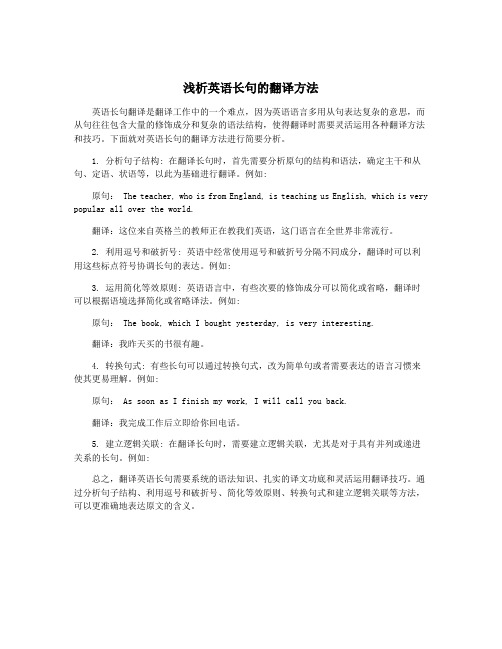
浅析英语长句的翻译方法英语长句翻译是翻译工作中的一个难点,因为英语语言多用从句表达复杂的意思,而从句往往包含大量的修饰成分和复杂的语法结构,使得翻译时需要灵活运用各种翻译方法和技巧。
下面就对英语长句的翻译方法进行简要分析。
1. 分析句子结构: 在翻译长句时,首先需要分析原句的结构和语法,确定主干和从句、定语、状语等,以此为基础进行翻译。
例如:原句: The teacher, who is from England, is teaching us English, which is very popular all over the world.翻译:这位来自英格兰的教师正在教我们英语,这门语言在全世界非常流行。
2. 利用逗号和破折号: 英语中经常使用逗号和破折号分隔不同成分,翻译时可以利用这些标点符号协调长句的表达。
例如:3. 运用简化等效原则: 英语语言中,有些次要的修饰成分可以简化或省略,翻译时可以根据语境选择简化或省略译法。
例如:原句: The book, which I bought yesterday, is very interesting.翻译:我昨天买的书很有趣。
4. 转换句式: 有些长句可以通过转换句式,改为简单句或者需要表达的语言习惯来使其更易理解。
例如:原句: As soon as I finish my work, I will call you back.翻译:我完成工作后立即给你回电话。
5. 建立逻辑关联: 在翻译长句时,需要建立逻辑关联,尤其是对于具有并列或递进关系的长句。
例如:总之,翻译英语长句需要系统的语法知识、扎实的译文功底和灵活运用翻译技巧。
通过分析句子结构、利用逗号和破折号、简化等效原则、转换句式和建立逻辑关联等方法,可以更准确地表达原文的含义。
英语长句翻译的技巧
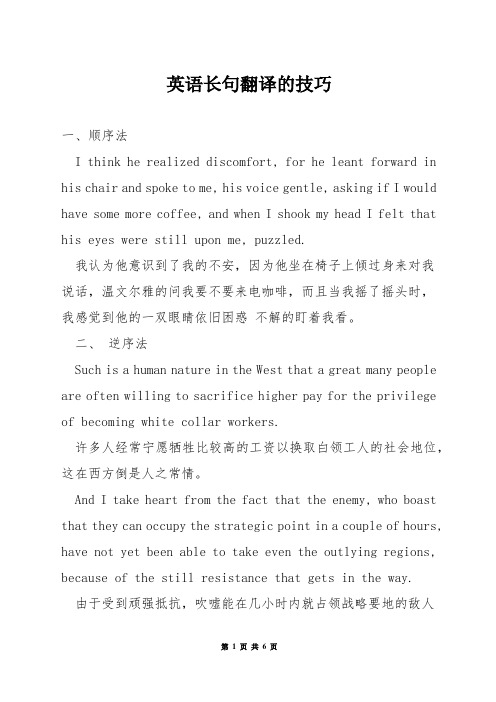
英语长句翻译的技巧一、顺序法I think he realized discomfort, for he leant forward in his chair and spoke to me, his voice gentle, asking if I would have some more coffee, and when I shook my head I felt that his eyes were still upon me, puzzled.我认为他意识到了我的不安,因为他坐在椅子上倾过身来对我说话,温文尔雅的问我要不要来电咖啡,而且当我摇了摇头时,我感觉到他的一双眼睛依旧困惑不解的盯着我看。
二、逆序法Such is a human nature in the West that a great many people are often willing to sacrifice higher pay for the privilege of becoming white collar workers.许多人经常宁愿牺牲比较高的工资以换取白领工人的社会地位,这在西方倒是人之常情。
And I take heart from the fact that the enemy, who boast that they can occupy the strategic point in a couple of hours, have not yet been able to take even the outlying regions, because of the still resistance that gets in the way.由于受到顽强抵抗,吹嘘能在几小时内就占领战略要地的敌人甚至还没能占领外围地带,这一事实使我加强了信心。
三、分译法The president said at a press conference dominated by questions on yesterdays election results that he could not explain why the Republicans had suffered such a side spread defeat, which in the end would deprive the Republican Party of long-held superiority in the House.在一次记者招待会上,问题集中于头一天的选举结果,总统就此发了言。
英语长句翻译的五种方法
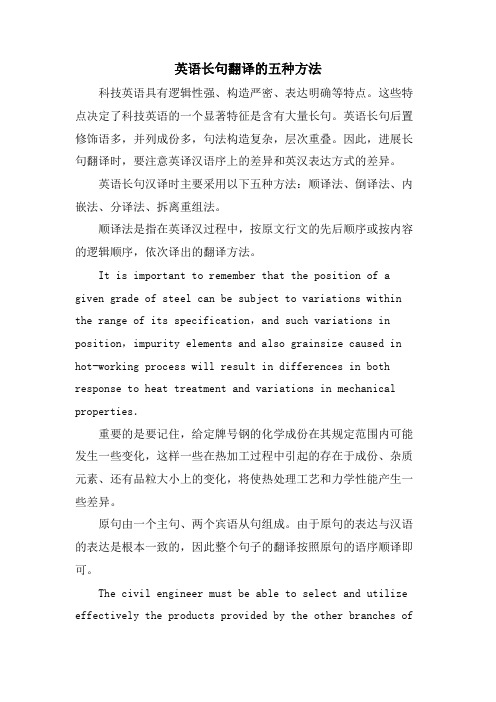
英语长句翻译的五种方法科技英语具有逻辑性强、构造严密、表达明确等特点。
这些特点决定了科技英语的一个显著特征是含有大量长句。
英语长句后置修饰语多,并列成份多,句法构造复杂,层次重叠。
因此,进展长句翻译时,要注意英译汉语序上的差异和英汉表达方式的差异。
英语长句汉译时主要采用以下五种方法:顺译法、倒译法、内嵌法、分译法、拆离重组法。
顺译法是指在英译汉过程中,按原文行文的先后顺序或按内容的逻辑顺序,依次译出的翻译方法。
It is important to remember that the position of a given grade of steel can be subject to variations within the range of its specification,and such variations in position,impurity elements and also grainsize caused in hot-working process will result in differences in both response to heat treatment and variations in mechanical properties.重要的是要记住,给定牌号钢的化学成份在其规定范围内可能发生一些变化,这样一些在热加工过程中引起的存在于成份、杂质元素、还有品粒大小上的变化,将使热处理工艺和力学性能产生一些差异。
原句由一个主句、两个宾语从句组成。
由于原句的表达与汉语的表达是根本一致的,因此整个句子的翻译按照原句的语序顺译即可。
The civil engineer must be able to select and utilize effectively the products provided by the other branches ofthe profession developing consumer goods,such as the materials of construction and industry,including steel,timber,concrete and many other materials;and engaging the modern application and use of steam,electric and gas power engines and machines.土建工程师一定要能够有效地选择和利用本行业和部门提供的产品。
英语长句的翻译方法
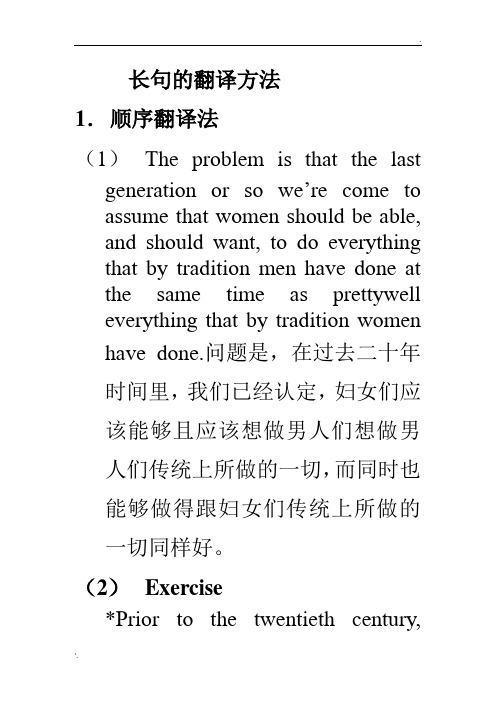
长句的翻译方法1.顺序翻译法(1)The problem is that the last generation or so we’re come to assume that women should be able, and should want, to do everything that by tradition men have done at the same time as prettywell everything that by tradition women have done.问题是,在过去二十年时间里,我们已经认定,妇女们应该能够且应该想做男人们想做男人们传统上所做的一切,而同时也能够做得跟妇女们传统上所做的一切同样好。
(2)Exercise*Prior to the twentieth century,women in novels were stereotypes of lacking any features that made them unique individual and were also subject to numerous restrictions imposed by the mali-dominated culture.2. 逆序翻译法(1)It therefore becomes more and more important that, if studentsare not to waste theiropportuniti es,there will have tobe much detailed informationabout courses and advice.因此,如果要使学生充分利用(上大学)的机会,就得为他们提供关于课程的更为详尽的信息,作更多的指导。
这个问题显得越来越重要了。
(2)Exercises*It is probably easier for teachers than for students to appreciate the reason why learning English seems to become increasingly difficult once the basic structures and patterns of the language have been understood.*A great number of graduate students were driven into the intellectual slum when in the United States the intellectual poor because the classic poor, the poor under the rather romantic guise of the beat generation, a real phenomenon in the later fifties.*Such a human nature in the west that a great many people are often willingto sacrifice higher pay for the privilege of becoming white collar workers.*Clear-cut guidelines and politics have been worked out and expressed in accurate language concerning the economy, politics, science and technology, education, culture and military and foreign affairs.3. 分译法翻译英语句子时,有时我们可以把原文的句子结构整个保存下来或只作稍改变即可,但在不少情况下则必须将原来的句子结构作较大的改变。
- 1、下载文档前请自行甄别文档内容的完整性,平台不提供额外的编辑、内容补充、找答案等附加服务。
- 2、"仅部分预览"的文档,不可在线预览部分如存在完整性等问题,可反馈申请退款(可完整预览的文档不适用该条件!)。
- 3、如文档侵犯您的权益,请联系客服反馈,我们会尽快为您处理(人工客服工作时间:9:00-18:30)。
长句的翻译方法摘要:本文简要地叙述了长句翻译的四种基本方法:顺译法、逆译法、分译法、综合法及其适用场合。
关键词:长句翻译顺译法逆译法分译法英语中的长句,无论多长,结构多么错综复杂,都是通过基本句型的扩展和变化得到的。
其扩展与变化的方法可以简要归纳如下六种:1.增加句子的修饰语(定语、状语等)。
例如:she’s a student.--→ she’s a excellent student.2.增加并列成分(并列主语、并列宾语、并列谓语、并列定语等)或并列句。
例如:sometimes, I go to school by bike.--→ sometimes, I go to school by bike or by bus.3.增加附加成分(插入语、同位语、独立成分等)。
例如:who is the most outstanding author?--→ who do you think is the most outstanding author?4.出现倒装或省略现象。
例如:there lived an elderly lady whose husband died long ago. --→ an elderly lady whose husband died long ago lived there.5.增加由短语或多级短语充当的成分。
例如:they are yours.--→ they are yours sooner or later.6.增加由长句或多级长句充当的句子成分。
例如:he knew how ashamed he would have been.--→ he knew how ashamed he would have been if she had known his mother and the kind of place in which he was born, and the kind of people among when he was born.以上我们讲述了长句是怎么来的,现在我们就讲一下长句应该怎么翻译、长句的翻译方法有哪些。
翻译的过程无非就是对句子的理解和表达过程。
理解过程,即对长句内容和结构的分析过程。
这个过程一般可以按照以下三个步骤进行。
1.结合语境,了解全句大意。
2.紧缩主干,确定句中的各种成分(主语、谓语、宾语等)。
3.剖析句子,分清句中主次成分及主从句关系。
表达过程就是借助翻译的一些方法,把自己从原句中理解到的意思用另一种语言表达出来。
其方法大致有以下四种:1.顺序法顺序法就是基本按照原句从句首到句末的顺序将其表述出来。
这个方法一般适用于有明显逻辑现象或时间先后顺序的长句中。
例如:A just retribution, however, quickly fell upon the Eagle. While hovering near an altar, on which some villagers were sacrificing a goat, shesuddenly seized a piece of the flesh, and carried it, along with a burning cinder, to her nest. A strong breeze soon fanned the spark into a flame, and the eaglets , as yet unfledged and helpless, were roasted in their nest and dropped down dead at the bottom of the tree. There, in the sight of the Eagle, the Fox gobbled them up.然而不久,鹰就得到了因果报应。
那时,一些村民正在祭坛杀一只山羊作为祭品,鹰在祭坛附近盘旋着,突然,她冲下去,抓起一块肉,带着这块上面还有未燃尽的木炭的肉飞回窝里。
一阵风把火星吹燃了,小鹰们羽毛尚未丰满,不能自救。
他们在窝里被烤着,又摔到树下,死了。
狐狸就当着鹰的面儿,把他们吃掉了。
逆序法有时英语长句的叙述层次与汉语相反,这是我们可以采用逆译法。
逆译法一般适用于以下情况:1)先说事情的结果后讲述原因的句子。
2)后带一连串修饰成分的名词性从句。
例如:Time goes fast for one who has a sense of beauty, when there are pretty children in a pool and a young Dinan on the edge, to receive with wonder anything you can catch!当你跟可爱的孩子们站在池子里,又有个年轻的狄安娜在池边好奇地接受你捉上来的任何东西的时候,如果你懂得什么叫美的话,时间是过得很快的!注意,翻译没有固定的方法,有时候,同一个句子,采用顺译法和逆译法的效果基本相同,此时可根据本人的习惯、风格进行翻译。
例如:Through scientific practice we’ve come to realize that matter can neither come from nought nor can it be reduced to nought; the total mass of reagents before reaction is constantly equivalent to that of resultants after reaction ---- the law of conservation of matter.顺译法:通过科学实践,我们认识到了物质不灭原则:物质不能由无到有;化学反应物的质量之总和与化学反应生成物的质量总和是恒等的。
逆译法:物质不能由无到有;化学反应物的质量之总和与化学反应生成物的质量总和是恒等的。
我们通过科学实践认识上述规律。
2.分译法分译法一般适用于主句与从句或主句与修饰语之间的关系并不十分密切的情况。
采用分译法时,常常为了体现句子的逻辑结构而选用以下方式:1)括号法括号一般作解释补充说明用,交代某一事实或引语的出处。
States and organizations having presented written or oral statements or both shall be permitted to comment on the statements made by other states or organizations in the form,to the extent, and within the time limits which the Court, or ,should it not be sitting, the president, shall decide in each particular case.凡已经提出书面或口头陈述或两项陈述之国家及团体,对于其他国家或团体所提之陈述,准其依法院(或在法庭开庭时,院长)所定关于每案之方式、范围及期限,予以评论。
2)冒号法冒号法可以避免重复,使译文清楚明了,特别适合科学数据的翻译。
例如:The general trend towards decreasing recovery of total product with increasing specific energy input is caused by increased removal of oxygen for more severe reaction conditions as well as greater distintegration of reacting particles from thermal shock and generally higher gas velocities throughout the collection system, with subsequent loss of more fine power in the cyclone exhaust.总产量回收率随着单位耗电量的增大而减小这一总的趋势,是由下列两个原因造成的:在较为强烈的反应条件下脱氧量有所增加,以及反应微粒因热震而较多碎解和整个吸尘系统中气体流速一般较高,从而使得随后在旋风除尘器排除气体中的细粉末损失量较大。
3)破折号法破折号常用于表示语流的中断、转折和跌进,也可以用以注释说明句中某一部分。
The snow falls on every wood and field, and no crevice is forgotten; by the river and the pond, on the hill and in the valley.雪,在四处飘落着。
雪花撒在树上,撒在田野里;撒在河边、湖畔、山上、谷底---- 没有一条岩缝墙隙里不萨撒满雪花。
3.综合法综合法就是在完全弄懂了英语原句的的句意后,按照汉语叙事论理的习惯,将句子重新组合,基本脱离原子的层次与结构。
它的好处是打破原句形式的约束,使行文愈加流畅自然;坏处是稍有不当便会扭曲原句的意思,误导了读者。
例如:In that infinitesimal fraction of time, inconceivable and immeasurable, during which the first atomic bomb converted a small part of its matter into the greatest burst of energy released on earth up to that time, Prometheus had broken his bonds and brought a new fire down to earth, a fire three million times more powerful than the original fire he snatched from the gods for the benefit of man some five hundred thousand years ago.在这难以想象,无法计算的刹那之间,普罗米修斯挣脱了身上的项链,又把新的火种送到了人间。
这时第一科原子弹把它的物质的一小部分化为地球上迄今为止所能释放出来的最大的能量。
这个新火种与大约五十万年前普罗米修斯为了造福人类从天庭盗走的旧火种相比,其威力要大三百万倍。
